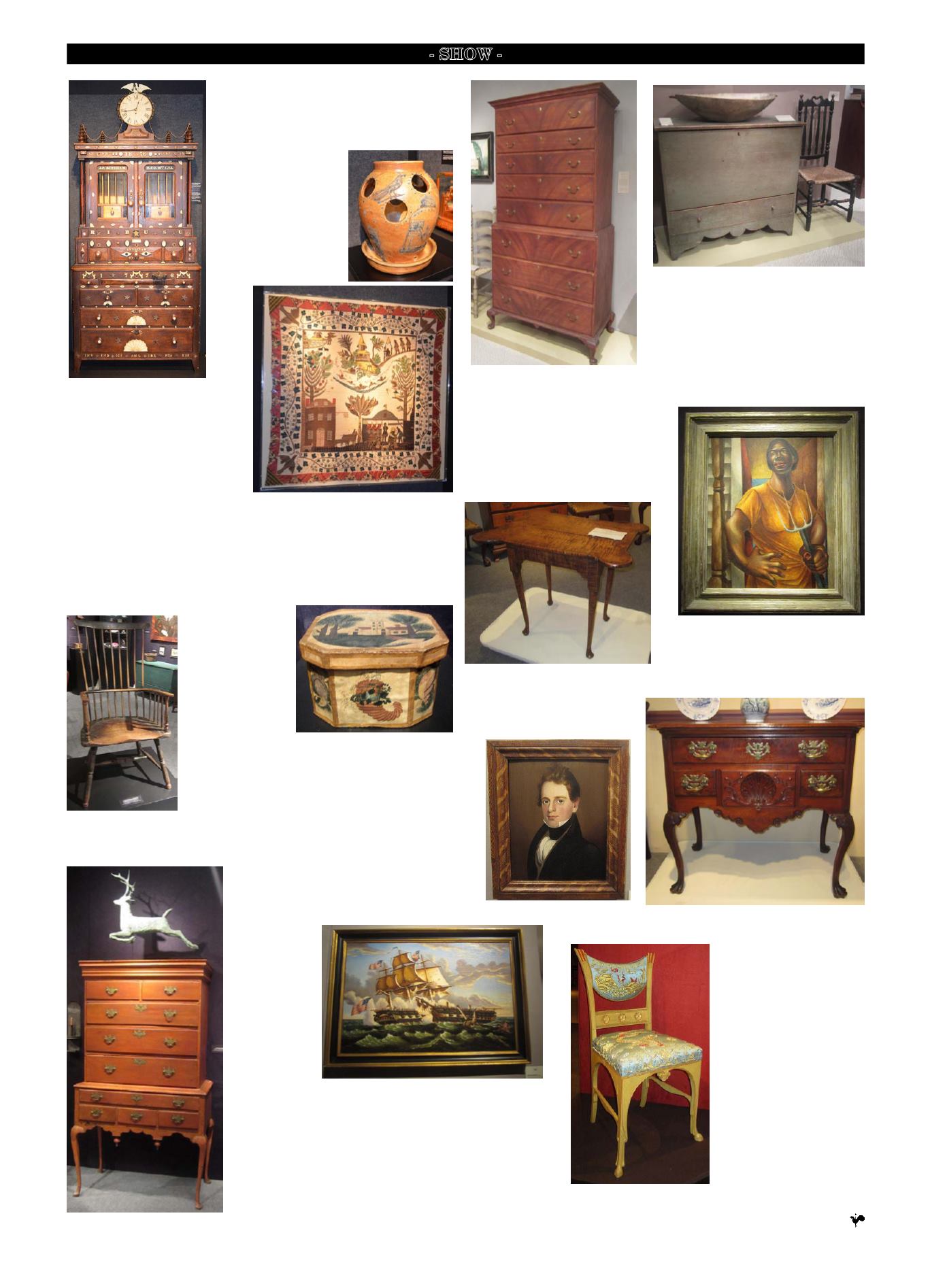

18-B Maine Antique Digest, April 2015
- SHOW -
The Bingham family Civil War memo-
rial secretary, Connecticut, dated 1876,
walnut, oak, ebony, poplar, pine, maple,
metal, glass, muslin, silk, bone, horn,
and abalone, 95½" high x 42¼" wide
x 19¼" deep, was $375,000 from Allan
Katz. It was made by a group of Wells
Bingham’s friends in remembrance of
his brother, John, who was killed in the
Battle of Antietam on September 17,
1862. It was presented to Wells Bing-
ham on July 4, 1876, in Hartford, Con-
necticut. The clock is a Seth Thomas
eight-day brass movement in working
condition and is topped with a carved
bone eagle with the words “The Union
Preserved” on its base. The inlay was
tested at the Scrimshaw Forensic Lab-
oratory and was identified as animal
bone.
Appliquéd and embroidered scenic panel by
Sarah Furman Warner Williams (1765-1848),
New York City and Vermont, dated 1798,
pieced, appliquéd, and embroidered cotton,
linen, and silk, 39" x 39¼", $400,000 from
Allan Katz. Other works by Sarah Williams
are in the Metropolitan Museum of Art, Win-
terthur, and the Henry Ford Museum, Dear-
born, Michigan.
Decorated salt-glazed stoneware bulb pot,
10½" high, probably Connecticut, circa 1820,
with cobalt-filled sgraffito decoration that
includes two figures, two American flags,
Masonic emblems, and fish. This is the only
decorated salt-glazed stoneware bulb pot
known to Wood-
bridge, Connecticut,
dealer Allan Katz,
who asked $125,000
for it.
Peter Eaton of Newbury, Massachu-
setts, offered the Kelly family grain-
painted chest-on-chest for $65,000.
This Queen Anne chest with a dry
grain-painted surface, original brasses,
skirt, cabriole legs, and a center drop in
the base molding is made of maple and
white pine; it was made in southeastern
New Hampshire, 1810-15. The top case
of the 80" high chest is 36" wide, and
the lower case is 38½" wide.
This small country painted chest with a cutout
base on both the front and sides is in a dry pale
blue paint. It was purchased in central Maine 25
years ago and was probably made there in the
first quarter of the 19th century. It was $11,500.
The maple bowl on top of it with very thin sides,
late 18th/early 19th century, was $7800. The
banister-back side chair with a heart in its crest
rail is one of a pair that sold; all were from Peter
Eaton.
Clifton-Carteret
lowboy,
1740s-50s, made for the Wis-
tar family, $250,000 from
Frank Levy of Bernard and S.
Dean Levy, New York City.
Tiger maple porringer-top tea table,
27¼" x 32" x 23¾
,
$65,000 from
Bernard and S. Dean Levy.
This watercolor painted paper box
sold at the Garbisch sale in 1980 for
$7975; it was priced at $35,000 by
David Schorsch and Eileen Smiles
of Woodbury, Connecticut. It sold.
The comb-back
P h i l a d e l p h i a
Windsor
with
original
green
paint, attributed
to Thomas Gil-
pin (1700-1766),
P h i l a d e l p h i a ,
Pe nn s y l v a n i a ,
circa 1750, white
oak and poplar,
45" high, seat
height 17½", was
$125,000
from
David Schorsch
and
Eileen
Smiles. It sold.
David Schorsch and Eileen Smiles offered the Warner
family QueenAnne painted high chest, Connecticut, prob-
ably Litchfield, circa 1760, poplar and white pine with old
salmon grain-painted decoration, 74½" high x 42" wide
x 21" deep. The leaping stag weathervane attributed to
Cushing and White was $38,000.
A pair of J.P. Morgan’s “Pom-
peiian” side chairs (one shown),
made by Herter Brothers, 1865-
1905, New York, painted and
gilt-flecked maple with uphol-
stered seats, are marked “426”
on the underside of the rear
aprons and “Morgan” in pencil
on the chair frames. The form
is Pompeiian in style. They are
from a set; there are five known
Pompeiian chairs from Mor-
gan’s drawing room. There is
photographic documentation of
the chairs in Morgan’s drawing
room in
Artistic Houses
,
vol-
ume 1, New York, 1883,
and in
the 1994 book
Herter Brothers:
Furniture and Interiors for a
Gilded Age
. There’s been some
conservation, and they have
been reupholstered. Associated
Artists, Southport, Connecti-
cut, asked $150,000 the pair.
T h o m a s
C h a m b e r s
(1808-1869),
The Capture
of the “Guer-
rière” by the
“ C o n s t i t u -
tion,”
signed
with
“TC”
m o n o g r a m ,
1840-50, oil on
canvas, 24" x
36", $125,000
from
Tillou
Gallery, Litch-
field, Connecticut. It sold. The subject was taken from an engrav-
ing after a composition by Thomas Birch and Michel Felice Cornè
in 1813. It was called one of Chambers’s best. Tillou also sold a
portrait of a boy by Chandler and a pair of portraits by Ammi
Phillips.
William Matthew Prior (1806-1873), portrait of a
gentleman, inscribed on the back “Painted in Port-
land [Maine], August 2, 1838/ Wm. M. Prior of
Bath,” oil on wood panel, 13" x 10¾", in excellent
condition in a period grain-painted frame, $13,000
from Tillou Gallery. Signed works on panel by Prior
are rare.
Charles White (1918-1979),
Our Land
,
1951, egg tempera on panel, 24" x 20",
signed and dated lower right, $450,000
from Jonathan Boos of New York City.










